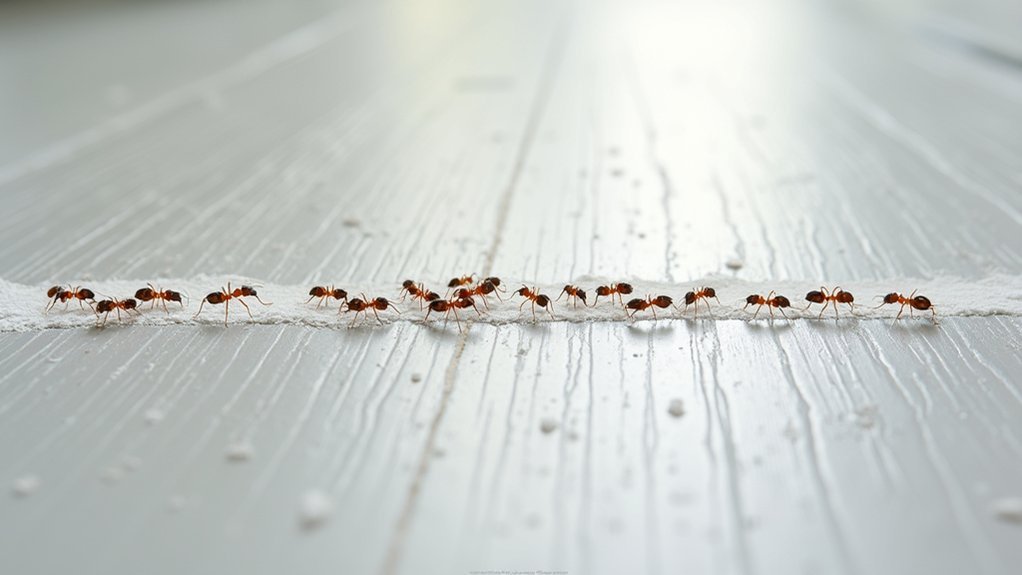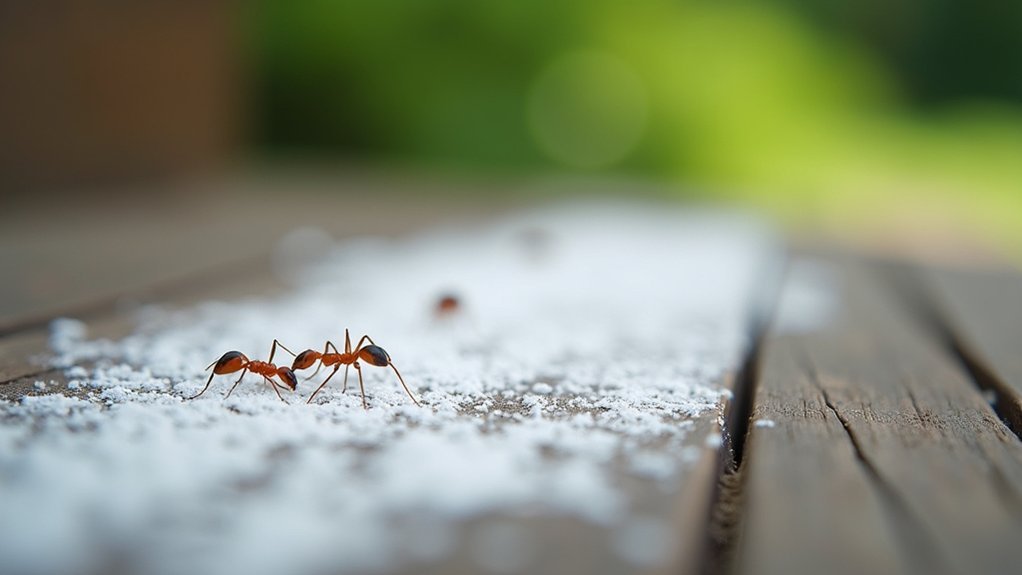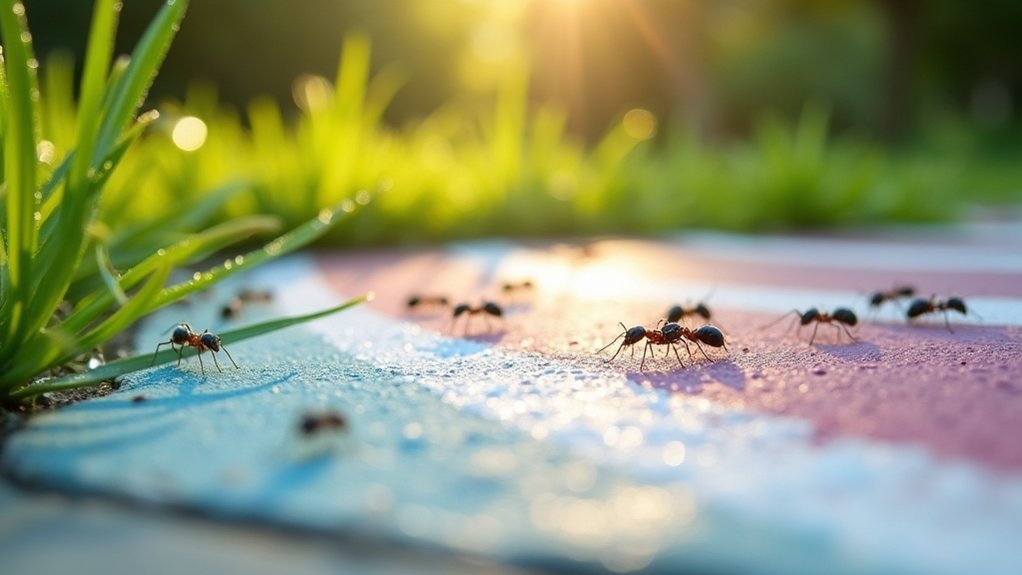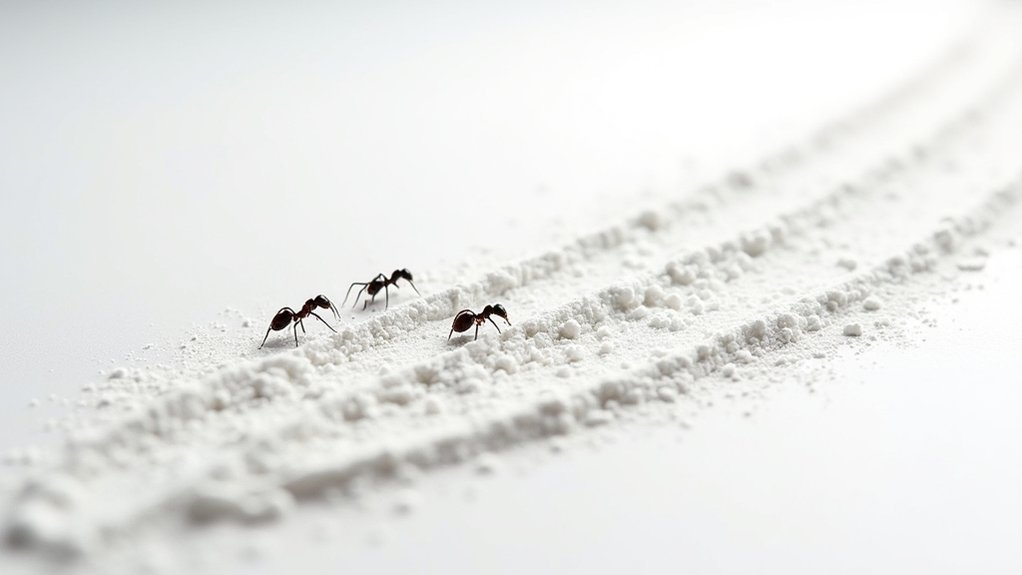Ants typically won’t cross barriers made from traditional white classroom chalk, powdered calcium carbonate, diatomaceous earth mixtures, boric acid-infused lines, or chalk infused with essential oils like peppermint or cinnamon. For best results, apply unbroken lines at least 2 inches wide around entry points and ant pathways, and reapply after cleaning or rain. Weather-resistant formulations work better outdoors, while compressed chalk sticks offer precision for indoor use. These simple barriers can greatly reduce ant traffic in your home.
Traditional White Classroom Chalk – The Original Ant Barrier

While many modern ant control solutions flood the market, traditional white classroom chalk remains one of the simplest and most accessible ant deterrents available. Composed primarily of calcium carbonate, this common teaching tool effectively disrupts ants’ pheromone trails, creating a barrier they’re reluctant to cross.
You’ll find that drawing chalk lines around specific areas—like pet food bowls or pantry entrances—provides immediate, though temporary, protection against ant invasions. The fine particles interfere with ants’ navigation systems, causing them to turn away rather than cross your defensive perimeter.
Remember that while this method works well for targeted ant control, it’s not an all-encompassing solution for larger infestations. Ants are resourceful creatures that will eventually find alternative routes around your chalk barriers.
Powdered Calcium Carbonate Lines – Industrial Strength Protection
Powdered calcium carbonate’s manufacturing process creates uniform particles that form impenetrable barriers against ant invasions in industrial settings.
You’ll get the best results by applying these lines precisely along entry points, ensuring complete coverage without gaps where ants might cross.
The particle size of industrial-grade calcium carbonate greatly impacts effectiveness—finer particles create denser barriers while coarser formulations offer improved weather resistance.
Manufacturing Process Analysis
When examining industrial-strength chalk lines for ant control, the manufacturing process becomes critical to their effectiveness. The production begins with limestone that’s carefully ground into an ultra-fine powder, creating the base calcium carbonate material.
Manufacturers then treat this powder through specialized processes that enhance both its purity and ant-repelling properties.
What makes industrial formulations superior to standard chalk is this precise manufacturing process. The carefully controlled grinding creates particles that more effectively disrupt ant pheromone trails while maintaining safety for your family and pets.
These industrial-strength versions also undergo treatments to improve weather resistance, allowing them to maintain effectiveness through varying conditions.
For reliable pest control, look for products that specify their industrial-grade manufacturing process, as these will typically require fewer reapplications and provide more consistent protection against ant invasions.
Precise Application Techniques
The manufacturing excellence of industrial chalk lines means little without proper application techniques. When dealing with ant invasions, you’ll need to correctly apply powdered calcium carbonate to disrupt pheromone trails effectively.
| Application Area | Width | Frequency | Notes |
|---|---|---|---|
| Doorways | 2 in. | Weekly | No gaps allowed |
| Windows | 1-2 in. | Bi-weekly | Continuous line |
| Kitchen perimeters | 2 in. | Weekly | Industrial strength |
| Foundation cracks | 1 in. | After rain | Double application |
For industrial strength protection, apply chalk lines at least 2 inches wide in a continuous, unbroken barrier. Even minor gaps will compromise effectiveness as ants will find alternative routes. Remember to reapply your calcium carbonate barriers after cleaning or rain to maintain their deterrent properties. Consistent application techniques guarantee those pheromone trails remain disrupted.
Particle Size Matters
Industrial strength protection against ants depends greatly on the particle size of your calcium carbonate barrier. When fighting ant invasions, finer powders create more effective deterrents by disrupting pheromone trails and preventing navigation across your defensive lines.
For maximum effectiveness when using powdered calcium carbonate:
- Choose industrial-grade formulations with smaller particle size for superior barrier properties
- Apply consistently to create an unbroken defensive perimeter around entry points
- Focus application along known ant foraging paths to maximize disruption of pheromone trails
- Reapply after cleaning or when lines become disturbed to maintain protection
While standard chalk offers some protection, the finer particles in industrial-strength calcium carbonate provide longer-lasting and more reliable results.
Combine this approach with other preventive measures for thorough ant management in your home.
Diatomaceous Earth Chalk Mixture – Dual Action Deterrent
Combining traditional chalk with diatomaceous earth creates a powerful one-two punch against ant invasions in your home.
This innovative mixture works on two fronts: the diatomaceous earth physically damages ant exoskeletons leading to dehydration, while chalk disrupts their pheromone trails, confusing their navigation systems.
To deter ants effectively, apply this mixture as a barrier around entry points, food storage areas, or anywhere you’ve spotted ant activity.
The best part? Unlike chemical repellents, this solution is non-toxic to humans and pets, making it ideal for households with children or animals.
Remember to reapply your chalk-diatomaceous earth line after cleaning or rainfall to maintain its effectiveness.
This simple, natural solution provides continuous protection against persistent ant colonies without introducing harmful chemicals into your living space.
Boric Acid Infused Chalk Barriers – Long-Lasting Defense

You’ll find boric acid infused chalk barriers most effective when applied in continuous lines around entry points and along detected ant pathways.
While mixing your own solution, wear gloves and keep these treatments away from children and pets as boric acid can be harmful if ingested.
The slow-acting toxin works particularly well against persistent species like carpenter ants and fire ants, which often resist traditional repellents.
Application Methods Matter
For a truly effective ant defense, boric acid-infused chalk barriers offer an unmatched dual-action approach that outperforms standard chalk lines.
When applying these pest control solutions, your technique directly impacts their effectiveness.
- Create continuous, unbroken chalk lines around entry points—any gaps will become ant highways into your home.
- Apply thicker lines in high-traffic ant areas, guaranteeing enough boric acid is available for ants to carry back to their colony.
- Reapply after cleaning or when lines become visibly worn to maintain the barrier’s integrity.
- Place lines in dry areas whenever possible, as moisture can dilute the boric acid concentration and reduce effectiveness.
Remember that proper application guarantees both the physical disruption of ant trails and the toxic effect reaches the entire colony.
Safety Considerations Required
While boric acid-infused chalk creates an impressive defensive barrier against persistent ant colonies, its toxicity demands careful handling and strategic placement.
You’ll need to keep these products well away from children and pets, as boric acid can cause harm if ingested or excessively handled.
When using these specialized barriers to combat ant infestations, always follow the manufacturer’s instructions precisely.
Wear gloves during application and wash your hands thoroughly afterward.
Consider placing the chalk in areas inaccessible to curious little fingers and paws, such as behind appliances or along baseboards.
Remember that safety considerations shouldn’t be overlooked in your quest to eliminate ants.
Even effective pest control solutions require responsible use.
For extensive protection, incorporate boric acid chalk as just one component of your overall pest management strategy.
Effectiveness Against Species
Boric acid infused chalk stands as the premier defense against multiple ant species, offering both immediate disruption and long-term protection.
You’ll find this solution particularly potent against persistent invaders like carpenter ants and fire ants when properly applied.
- Carpenter ants – The boric acid disrupts their pheromone trails while acting as a slow-acting poison that targets their digestive system.
- Fire ants – When mixed with sugary substances, the boric acid becomes an attractant that lures these aggressive ants back to their colonies.
- Common household ants – The chalk barrier prevents re-establishment of trails, unlike traditional chalk lines.
- Multiple species control – Target high-traffic areas for maximum effectiveness, as the compound remains active for several weeks, providing sustained protection.
Sidewalk Chalk With Essential Oils – Scented Perimeter Control

When traditional chalk barriers prove insufficient against persistent ant colonies, sidewalk chalk infused with essential oils offers a powerful upgrade to your perimeter defense strategy.
This scented perimeter control works in two ways: the chalk provides a physical barrier while the oils disrupt ant pheromone trails that guide their fellow workers.
For maximum effectiveness, look for formulations containing peppermint, eucalyptus, or tea tree oils.
These potent scents mask the chemical signals ants depend on for navigation, making them less likely to cross your protective boundary. You’ll also enjoy the pleasant aromatherapy benefits in your outdoor spaces.
Remember that while scented chalk creates an effective temporary deterrent, you should incorporate it into a broader pest management approach for long-term ant control.
Non-Toxic Colored Chalk for Indoor Ant Management
When drawing chalk barriers to manage indoor ants, you’ll want to apply a continuous, unbroken line around ant-prone areas like pet food bowls or pantry entrances.
Colors like blue and red have proven particularly effective as ant deterrents, making them your best choices when selecting chalk for this natural pest control method.
You can enhance your chalk barrier’s effectiveness by reapplying after cleaning and combining it with essential oils like peppermint or cinnamon for a multi-sensory ant repellent.
Safe Application Techniques
Drawing strategic chalk lines around your home provides a simple yet effective way to deter ants without using harsh chemicals. When applying non-toxic colored chalk, precision matters to create barriers ants won’t cross.
- Draw continuous, unbroken chalk lines around entry points like windows, doorways, and cracks where ants might enter.
- Create protective boundaries around specific areas you want to keep ant-free, such as pet food bowls or pantry shelves.
- Reapply chalk lines regularly, especially after cleaning or when lines become faded or smudged.
- Store your chalk safely away from children and pets, as even non-toxic varieties can pose ingestion hazards.
Remember that while chalk lines effectively disrupt ant pheromone trails temporarily, they should be part of a broader pest management strategy for lasting results.
Effective Color Selection
Although many homeowners simply reach for any available chalk, choosing the right color greatly impacts your ant deterrent strategy. Bright colors like white, yellow, and blue offer superior visibility for both you and the ants, making them excellent choices for effective color selection.
These vibrant hues help disrupt ant pheromone trails more efficiently when applied strategically around entry points and food sources.
When shopping for non-toxic colored chalk, always verify product labels to confirm they contain safe ingredients like calcium carbonate without harmful additives. The effectiveness varies by ant species, so observe how your local ants respond to different colors.
Remember that while chalk creates temporary barriers, it works best as part of a thorough approach to indoor ant management. Combine color-specific deterrents with proper food storage for ideal results.
Weather-Resistant Outdoor Chalk Formulations

Despite outdoor conditions presenting challenges for ant barriers, weather-resistant chalk formulations offer exceptional durability that standard varieties simply can’t match.
These specialized products contain additives that enhance surface adhesion, allowing them to withstand rain, humidity, and sunlight without quick deterioration.
When selecting outdoor chalk for pest control, consider these advantages:
- Enhanced longevity reduces the frequency of reapplication around your home’s perimeter
- Non-toxic ingredients make them safe for households with children and pets
- Superior adhesion to outdoor surfaces maintains barrier integrity even during light rainfall
- UV-resistant properties prevent rapid breakdown from sun exposure
These weather-resistant formulations effectively disrupt ant pheromone trails while requiring less maintenance, making them ideal for creating persistent barriers at entry points around your property’s exterior.
Compressed Chalk Sticks for Precise Application
The compressed chalk sticks offer unmatched precision when creating ant barriers around your home. Unlike standard pest control options, these specialized sticks allow you to draw thin, continuous lines that effectively disrupt ant pheromone trails, preventing infestations in targeted areas.
Typically packaged in multi-stick bundles, these chalk sticks contain calcium carbonate and talcum powder, enhanced with insecticides like boric acid for maximum effectiveness. You’ll find they resemble traditional sidewalk chalk but are specifically formulated for pest control purposes.
Apply these sticks around food bowls or entryways to create barriers ants won’t cross. Remember to use them cautiously, especially in homes with children and pets, as ingestion can pose health risks.
For precise application in problem areas, compressed chalk sticks provide an effective solution to your ant problems.
Pure Talcum Powder Lines – Minimal Residue Option

For households seeking a cleaner alternative to compressed chalk sticks, pure talcum powder lines offer an elegant solution to ant problems. This natural deterrent effectively disrupts pheromone trails while leaving minimal residue on your surfaces, making cleanup considerably easier.
- Simply create a thin, continuous line of talcum powder where ants frequently travel.
- Reapply after cleaning or when you notice the barrier becoming less effective.
- Feel confident using around children and pets due to its non-toxic properties.
- Combine with other ant control methods for maximum effectiveness.
You’ll appreciate how talcum powder barriers maintain your home’s appearance without unsightly chalk marks.
While results may vary depending on ant species and environmental factors, many homeowners find this cleaner option provides reliable protection when consistently applied.
Cinnamon-Infused Chalk Barriers – Aromatic Ant Deterrent
Combining traditional chalk lines with potent cinnamon powder creates a double barrier that ants actively avoid while traveling through your home.
The cinnamon-infused chalk works by disrupting pheromone trails ants use to navigate, fundamentally creating confusion in their ranks.
Ants rely on chemical roadmaps, but cinnamon chalk scrambles their internal GPS, leaving colonies disoriented and retreating.
You’ll appreciate this natural ant deterrent if you have children or pets, as it avoids toxic chemicals while still providing effective protection.
The aromatic compounds in cinnamon irritate ants’ senses, causing them to seek alternative paths away from your living spaces.
For best results, reapply your cinnamon barriers regularly, especially after cleaning or when you notice the scent fading.
While not a permanent solution for severe infestations, these aromatic boundaries can considerably reduce ant traffic in problem areas throughout your home.
Frequently Asked Questions
What Line Will Ants Not Cross?
Ants won’t cross chalk lines because they disrupt pheromone trails. You’ll find they avoid lines of powdered substances like diatomaceous earth, cinnamon, and coffee grounds that interfere with their navigation abilities.
What Kind of Chalk Repels Ants?
Calcium carbonate chalk disrupts ants’ pheromone trails, making it a temporary deterrent. You’ll find “Chinese Chalk” containing boric acid more effective, though it’s potentially unsafe. Natural talcum-based chalks can work but aren’t long-term solutions.
Is There a Barrier That Ants Won’t Cross?
Yes, several barriers deter ants effectively. You’ll find diatomaceous earth, petroleum jelly, cinnamon, vinegar, and commercial ant repellents create boundaries ants typically won’t cross. For persistent infestations, consider professional pest control solutions.
What Substance Will Ants Not Cross?
Ants won’t cross chalk lines, diatomaceous earth, or cinnamon. You’ll find they also avoid coffee grounds, vinegar, and essential oils like peppermint. These substances disrupt their chemical navigation signals, deterring their movement.
In Summary
You’ve now got an arsenal of chalk options to keep your home ant-free naturally. Whether you choose traditional classroom chalk or cinnamon-infused barriers, consistency is key. Remember to reapply after rain or heavy cleaning. These simple chalk lines create boundaries ants won’t dare cross, giving you peace of mind without harsh chemicals. Try different options until you find what works best for your specific ant problem.





Leave a Reply